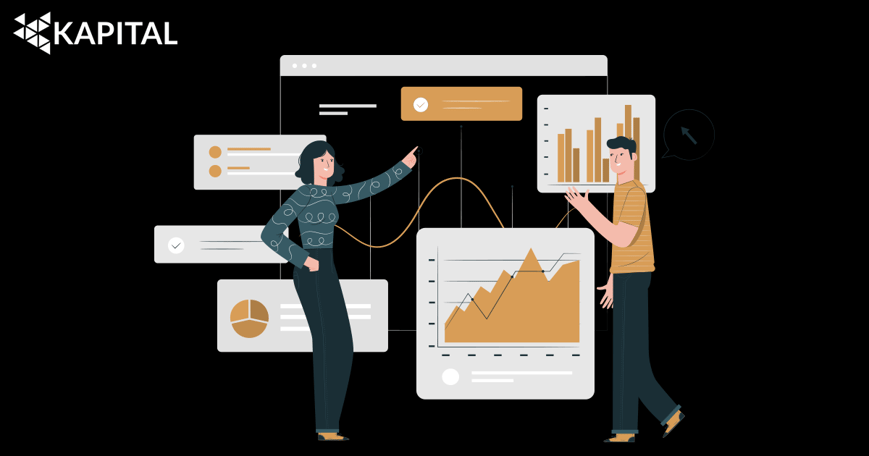Why Your Talent Acquisition Should be Data-Driven
4 out of 10 Employers say that the candidate did not show up in the last stage of the interview or at the offer stage for no apparent reason - Shows research by Robert Half. This is popularly known as candidate/applicant ghosting. If you were not already aware, let us inform you that candidate ghosting is on the rise.

Ever thought about why this is even happening in the very first place?
There could be multiple reasons, but a specific one that stands out is: not having a proper data-driven recruitment process in place. We cannot stress enough how important it is to identify the right candidate who will be with you in the long term or until the job requires. Data-driven recruitment is the key to attracting and keeping the right talent needed to meet business objectives without you having to incur bad-hire costs.
The recruitment process is a treasure chest of information that, when carefully mined, provides essential information about whether or not a candidate will be the high-performing employee your organization is on the lookout for. The recruitment team needs a streamlined method of connecting all employee data, from sourcing to hiring and beyond, and tying it into their strategic workforce planning. Recruiters may more easily and efficiently address the goals of the organization with this complete picture at their fingertips.
A great way to implement the above is by tracking various metrics. The metrics we track at KAPITAL, and you could too, are:
- Source of Hire
- Time to Fill
- Time-to-Hire
- Time in Process Stage
- Retention Rate
- Cost Per Hire
- Applicants Per Opening
- Applicants Satisfaction
- Offer Acceptance Rate
- Quality/Productivity of Hire
How will tracking metrics help, you may ask?
The listed metrics are measurements that we use to get better hiring results. These measurements will indicate which hiring functions are performing well and could use improvement. This helps us bring structure to our hiring process.
Now let’s break it down further to understand how incorporating data into your hiring process can reverse candidate ghosting and help you hire employees who will stay.
Here are a few benefits of data-driven hiring:
Improves Candidate Experience
A survey of over 1,500 employees and job seekers discovered that 84 percent of respondents are looking for, or are open to, a new job in the next six months, while over 60 percent of job seekers are unimpressed by time-consuming recruitment processes and are demanding companies create a more modern recruiting experience, according to the 2022 Greenhouse Candidate Experience Report.
Analytics brings the factors that impact candidate experience to the forefront, and a workforce intelligence solution can help you quickly measure the effectiveness of each. Whether it’s the time since initial contact, the time between stages, the interviewer's name, etc., you will be able to tell what’s increasing or decreasing the likelihood of a candidate withdrawing their application and create strategies to decrease the odds of losing strong candidates.
Emphasize Quality/Productivity of Hire
Selecting the best candidate based on assessment scores, and structured interview results is an effective hiring method. Recruiters need a clear vision of hiring plans to help them determine when is the right time to hire talent. Without better technology and all employee data available in a single system, recruiters will be hard-pressed to deliver the optimal headcount needed to deliver on business goals.
Cost-Effective
Data-driven hiring can help you cut down your bad hire cost and other cost-related variables optimally. To wisely spend your budget, track Source of Hire to determine which recruiting channels bring in the most qualified candidates.
Further, online application and pre-screening of candidates based on the details submitted by them and data available on the various tools can help you cut costs and time. Through this, you can easily rate the different hires and also eliminate the ones which do not fit the requirements. This also helps you cut the time spent on scheduling interviews, screening, and communication. KAPITAL does this with the help of our DreamHire platform, and it has truly reduced our time-to-hire as well as cost per hire.
Multiply Speed to Hire
Wouldn't it be great if you could give stakeholders more precise hiring time estimates? When done correctly, workforce analytics allows you to know how long it will take to hire for a specific role, including time spent at each stage of the process. You can deliver more accurate deadlines to stakeholders with this information. Similarly, this data-driven strategy can show the bottlenecks slowing down hiring and advise you on how to fix them. For example, track how many emails your hiring team members exchange with candidates to see if there are specific stages where you can speed up your time-to-hire.
Know Your Hiring Capacity
Hiring is a fine balance: over-hiring might result in unnecessary costs, while under-hiring can lower productivity. Recruiters require fact-based hiring plans that are constantly updated to reflect the most current status of the organization to stay on track. Data-driven Talent Acquisition may build more accurate hiring plans using estimates based on historical rates for aspects like employee attrition, internal movement between departments, and hiring success using data-driven workforce planning.
Here’s our client Margie Doggett, Senior Manager of Corporate Applications (Workday) at Ipas, talking about her experience with KAPITAL and how when no other recruiter (Internal or external) could help her out, KAPITAL came to her rescue -
The result our client has seen in the clip above is the kind of outcome that data-driven talent acquisition helps you achieve. Without data, you won’t be able to tell if your recruiting process is working effectively or, if not, why not. That is what makes KAPITAL stand apart from our competitors when it comes to hiring the right fit.


